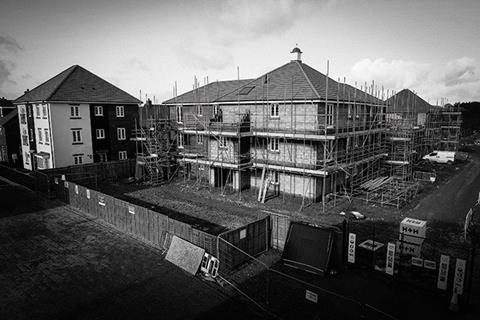For some, last week’s housing white paper wasn’t worth the white paper it was printed on, but for others it presents a radical shift in policy away from home ownership and towards a much wider range of housing needs. Joey Gardiner assesses who’s right

Just one week on from the launch of the government’s long-awaited housing white paper the verdict is clear: a great big let down. “A missed opportunity”, said the Adam Smith Institute. “A predictably damp squib”, said estate agent Colliers International. A synopsis of a crisis with “almost nothing to actually effect change”, said planning consultant Iceni Projects. “The government has bottled it”, said housing campaign group Priced Out.
While prime minister Theresa May hailed it as a “critical step” toward building a Britain “that works for everyone”, and communities secretary Sajid Javid (pictured) called it “radical lasting reform that will get more homes built right now”, Dave Sheridan, chief executive of housing contractor Keepmoat, agrees with the critics. “It’s a decent piece of research,” he says, “but there’s nothing new in terms of messaging, and it’s not giving clarity around the things we need to move forward.” So do the government or the critics have the true assessment?
Gear change
The negative reaction is understandable. Packed with lots of exhortation, numerous modest technical tweaks and many broadly sketched new ideas which require lengthy consultation (see “White paper at a glance”, overleaf), the white paper – Fixing our broken housing market – contains no new funding for the sector, and it is tough to work out what all its many small parts add up to.
The government is now accepting that we have a crisis of supply, not of home ownership. This is a big, big step
Lord Kerslake
While the David Cameron administration had a bold and eye-catching 200,000-home Starter Homes programme, there is nothing similar here, and no big shiny numbers for the press to grab on to. Next to the Starter Homes ambition, the white paper’s pledges to “plan for the right homes in the right places” and “diversify the housing market” can be dismissed as the woolliest of warm words.
Still, there are those who feel this negative reaction risks missing the significance of the much bigger picture shift this white paper represents.
A shift away from a Cameron government obsessed to the exclusion of all else with homes for sale and the big housebuilders that build them.
For some, such as former Homes and Communities Agency boss Lord Kerslake, now chairman of housing association Peabody, this single-minded focus had risked seriously limiting the nation’s ability to build. “The government is now accepting that we have a crisis of supply, not of home ownership, and that housing associations can play a part. It sounds small but this is a big, big step.”
Starter homes – a non starter?
Why this is so significant requires rolling back a year, when Brandon Lewis was housing minister. Working to an agenda heavily influenced by Cameron and his chancellor George Osborne, Lewis’ tenure not only saw the attempted roll-out of Starter Homes (homes for sale at a 20% discount – a manifesto pledge this week quietly dropped), but also the complete removal of subsidy for building homes for rent, the controversial introduction of the Right to Buy for housing association tenants, a 3% stamp duty surcharge on sales of homes for rent, and the imposition of annual rent cuts for housing associations, which the National Housing Federation said would cut development capacity by 27,000 homes. Lewis dismissed opposition from campaigners worried about the impact on people unable to afford to buy as “thin-lipped sneering at any council tenant who dares to want … what 86% of the country wants: the chance to buy their own home”.
It was not just the social housing lobby that worried; developers, too, raised concerns about the impact of Starter Homes and that this overall approach would reduce tenure diversity and business models, and discourage the burgeoning Build to Rent sector. While housing associations worried that turning a fifth of every site into starter homes would squeeze out other types of affordable housing, developers worried about the impact on their sales, and (along with mortgage lenders) whether the discounted homes would undermine the value of their full-price houses.

Matthew Spry, senior director at planning consultant Nathaniel Lichfield & Partners, says: “Starter Homes was one of those policies that wasn’t sufficiently well developed and would have had significant unintended negative consequences.” Ultimately, the white paper has proposed giving councils control over how many starter homes are built – seen as likely to result in very few. Keepmoat’s Sheridan says: “This relaxation is fantastic. The odd area I’m sure will want them, but they’re not going to be imposed.”
A step back for the big developers
The extent of the U-turn here is demonstrated by the fact the white paper policy is actually similar to a proposal Lord Kerslake made in the House of Lords a year ago, which was angrily fought down by the government at the time. It led to Lewis describing Kerslake in the Sun as an unelected peer and “owner of his own home who is trying to stop others from owning theirs”.
The volte-face on Starter Homes is actually just one instance of this wider policy shift away from a housebuilder-centric view of the world. Former Housing Corporation chief executive Steve Douglas, now founding partner of consultant Altair, says: “Less than a year ago you couldn’t talk to government about rented housing, you couldn’t talk about the non-private sector.
Less than a year ago you couldn’t talk to government about rented housing. The tone now feels very different
Steve Douglas, Altair
The government was in thrall to the largest developers. The tone now feels very different.”
Frustration at the lack of positive new measures in the white paper must be put in the context of the amount of work needed to reverse out of many of the policy directions of the previous administration. For example, the white paper talks about supporting the “vital role” of housing associations in building the required homes. Richard Jones, partner at consultant Arcadis, says: “Last year the rhetoric was that you had a lot of lazy RPs [housing association registered providers] sitting on their hands with development, getting beaten up by government. Now it is exactly the opposite.”
Alongside the rhetoric, the white paper promises to engage with housing associations to create a long-term rent settlement, reform and rebrand the Homes and Communities Agency which funds them, pilot bespoke housebuilding deals with local authorities, and reform planning rules to promote homes for rent.
Duncan Field, partner at law firm Norton Rose Fulbright, says: “Although the white paper has had a mixed reaction, for the first time that I can remember the government has embraced all types of housing needs and housing products. For that reason alone the initiatives they have come up with are likely to be more effective than others we have seen in the past.”
Brendan Sarsfield, chief executive of one of the largest housing associations, Family Mosaic, which aims to rent out a third of the homes it builds, says: “The message I get from this is that at least government is no longer going to get in the way.” Significantly, even the Home Builders Federation is welcoming the shift to a broader-based market. HBF executive chair Stewart Baseley says: “The government is continuing to support housebuilders, but it’s quite right that the government isn’t solely focused on home ownership and looks to support the supply of other tenures.”
White paper at a glance
- Councils to be held to account for delivering the number of homes identified in their local plans. Within three years, if annual delivery is less than 65% of expected level, then presumption in favour of development applies
- Suite of measures to boost site build-out rates by housebuilders, including reducing planning permission length from three to two years, and consulting on allowing councils to take previous build-out track record into account
- Support for housing associations through new rent settlement
- Support for Build to Rent sector by making councils plan for it for the first time
- Ability for councils to raise planning fees by up to 40% to pay for more planners
- Reform of Community Infrastructure Levy delayed by new consultation, to report at autumn Budget
- Planning measures to encourage high-density development around transport hubs

From rhetoric to reality
Nevertheless, even those who applaud the significance of the philosophical shift recognise more needs to be done to follow through on the rhetoric. Arcadis’ Jones says: “It feels like a bit of a lightbulb moment – but that they haven’t yet thought through how they will really translate this realisation into reality. It needs to be a lot more practical – what are the measures that will make this happen?” Similarly, Altair’s Douglas says: “The big thing will be getting from this white paper to delivery. It’s not yet clear what the levers and sanctions are going to be.”
The chief concern of those worried about this lack of delivery focus is the failure to significantly change green belt policy [see No loosening of the green belt, below right]. But critics also point to the failure to reverse divisive policies such as housing association right to buy, this parliament’s rent cuts and the stamp duty surcharge for rented housing. While the housing association sector has an ambition to build 120,000 homes a year, James Prestwich, the National Housing Federation’s policy head, admits the white paper itself is not going to get the sector there. “The government could have come out stronger, particularly on the green belt.”
Peabody’s Kerslake says the white paper could have delivered further funding for infrastructure and building up capacity in local authorities, and explored more radical policies such as relaxing local authority borrowing, and the setting up a of a revolving housebuilding fund. “The policy environment is now as good as it’s been for a while, but the valid question is: ‘Is this enough?’ Even more is needed.”
It feels like a lightbulb moment – but they haven’t thought through how to translate it into reality
Richard Jones, Arcadis
Modernise or Die report author Mark Farmer, founder of consultant Cast, says some critics miss the fact much of the more radical innovation needed to drive diversity of delivery is starting to occur under the radar, through the Homes and Communities Agency’s administration of funding pots such as the £2bn accelerated construction fund, promoting off-site construction.
“I would not be surprised if the leadership that people are worried is lacking in this white paper is actually driven by a proactive approach from the HCA. Their view seems to be we’ve had enough of the situation – and we’re going to sort it out.”
The cold reality, however, is that for those who like change to be revolutionary, this white paper was always going to disappoint. The government’s policy is driven by its commitment to build one million homes in this parliament – and the most recent net additions figures show it is broadly on track to hit it. NLP’s Spry says: “The context is that last year the current system, despite all the acknowledged problems, delivered nearly 200,000 net additions. Therefore, the key for the government has been not to introduce radical changes that risk creating a hiatus.
“It’s more an exercise in smoothing off the rough edges of the previous programme, and in that it’s probably been quite effective.”
Cast’s Farmer agrees that getting the basics right will be more useful than attention-grabbing initiatives. “I’m not after gimmicks,” he says.
“I’m after a steady direction of travel, which this provides.” If the direction of travel is right, the question remains whether the white paper on its own provides enough fuel to reach the destination.

No loosening of the Green belt
The white paper was originally expected to contain significant relaxation of green belt planning restrictions. However, there has been much speculation that delays to its publication were a result of pressure from backbench Tory MPs unhappy at this shift. The National Planning Policy Framework currently outlaws new building in the green belt except in “very special circumstances” and says green belt boundaries can only be altered “in exceptional circumstances”.
Developers have long argued that much of it is of poor environmental quality, close to transport links and could be built on without undermining its purpose. An Adam Smith Institute report in 2015 argued a million homes could be built with release of just 3.7% of London’s green belt.
Ultimately, the white paper proposed only a very minor change. This is that existing restrictions remain in full force, but the “exceptional circumstances” that can prompt a green belt review were detailed for the first time. Stewart Baseley, executive chair at the Home Builders Federation, said it was a positive change, that “strengthened protections” and meant local authorities can no longer hide behind being green belt constrained and have to find a way of meeting their housing need”. However, the NHF’s Prestwich joined others in calling it a missed opportunity. “It’s a highly contentious issue and clearly people in the Conservative Party take divergent views on it. My sense is it [the white paper] got watered down,” he says.




























No comments yet